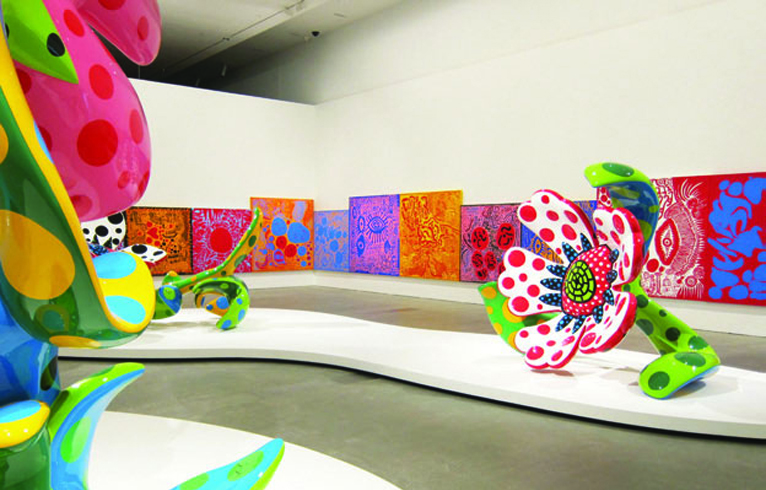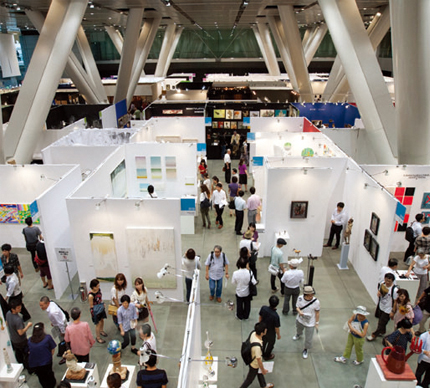THE GAME POST-GINZA: CONTEMPORARY IN TOKYO
| May 21, 2012 | Post In LEAP 14

Tokyo has long been known for its cultural exports, and the present is no exception. However, in terms of contemporary art, the city’s galleries are faced with the decision to either move ahead into a truly cosmopolitan future, or remain behind in an antiquated past.
Japanese art is at an international high just now. Yayoi Kusama’s sprawling retrospective at the Tate Modern is winning rave reviews. Mono-ha master Lee Ufan’s 2011 retrospective made him only the third Asian artist to be honored with a one-man show at the Guggenheim in New York. And later this year, New York’s MoMA will launch an exhibition of experimental Tokyo-based practice from the late 1950s and 60s. But if Japanese postwar cultural exports from several decades ago are now garnering belated success abroad, contemporary art in the present tense seems to be falling behind a little back home. Just as Japan’s harder industries are now making concerted efforts to break through the isolationist “Galapagos” mentality and cultivate foreign audiences and clientele, local galleries are venturing abroad regularly to represent their artists in newer, untested markets.
Whereas an Asian art hub like Hong Kong can boast a truly cosmopolitan milieu, Tokyo can often seem positively provincial. After Gagosian and White Cube established outposts in the city, Galerie Perrotin and Lehmann Maupin are also busy planning their first foray into the Asian market there after testing the waters at Art HK. In terms of the varied international provenance of the gallery scene, there is nothing even remotely comparable in Tokyo.
The oft-cited explanation for this is the plain fact that there just aren’t many contemporary art collectors in Japan. In Tokyo’s Ginza district, where the city’s fine art galleries have traditionally congregated, there is still a conspicuous bias towards more traditional Japanese arts and crafts. The overwhelming majority of Ginza galleries continue to operate on an antiquated “rental” system, where artists pay weekly fees of up to JPY 300,000 to exhibit their work, with no curatorial presence whatsoever. An important exception is Japan’s first contemporary art gallery, Tokyo Gallery, which was founded by Takashi Yamamoto in 1950. Having championed the work of artists from several successive Japanese avant-gardes, such as the Gutai Art Association and the Mono-ha group in its formative years, over the past decade it seems to have shifted its efforts towards forging more intra-Asian links, in particular with China and Korea.

A similar shift can be seen at Art Fair Tokyo, which this year has found a promising new director in Takahiro Kaneshima, an ideal candidate for leading the international charge if there ever was one. Kaneshima used to direct Tokyo Gallery + BTAP’s operations in Beijing, and currently also oversees Far East Contemporaries, a Yokohama-based curatorial unit with a marked predilection for Chinese artists. Although Kaneshima’s push for Art Fair Tokyo to assume a more Asian identity is clear— see this year’s “Discover Asia” section debut— the fact remains that the fair has been having trouble distinguishing itself as a Tokyo-based platform for the best contemporary art because it also welcomes antiquities, ceramics and crafts dealers. In any case, few foreign galleries outside an elite coterie of East Asian stalwarts like Arario and Tina Keng have chosen to stop by Tokyo on their global fair calendar. If Art HK already seems to have claimed its niche as Asia’s top Western-centric art fair, perhaps this shift towards a vaguely north Asian focus is Tokyo’s best bet.
Meanwhile, Tokyo’s most cosmopolitan dealers have chosen to skip Art Fair Tokyo and take their business elsewhere. Taka Ishii, Shugoarts and SCAI the Bathhouse are all regular fixtures at both European fairs like Art Basel and Frieze, and promising Asian pastures like Art HK and Art Beijing, where they have successfully courted international interest in their artists. Shugo Satani of Shugoarts, however, was quick to emphasize, “We have never deprecated the Asian market per se. Last year was the first time that we dropped out of Art Fair Tokyo, and participated in G-tokyo (a smaller “boutique” art fair in February featuring only 15 galleries). We’ve decided that there is no longer any potential at AFT for promoting the artists we represent.”
If non-participation in Art Fair Tokyo betrays a weak domestic contemporary market, several top Japanese galleries have been actively seeking out other client bases, deciding to strengthen links with Asian collectors in particular. Tokyo’s Wada Fine Arts, whose stable of artists was until very recently almost exclusively Japanese, sold out its entire booth of paintings by Filipino “magic realist” Rodel Tapaya at Art Stage Singapore in January. Later this year, Ota Fine Arts, Mizuma Gallery and Tomio Koyama Gallery will open new branches in Singapore’s Gillman Village. For these galleries who deal in the craft-heavy, neo-nihonga style, it makes perfect sense to establish an outpost in Southeast Asia, where many like-minded Indonesian, Filipino and Taiwanese collectors are based.
As Tokyo’s more established galleries extend their reach abroad with artists whose reputations have already been burnished, a younger cohort of dealers have been quietly trying to build local and international recognition for artists who just don’t fit the existing “Superflat” or “Micropop” conceptions and labels that continue to dog Japanese contemporary art. The real push towards so-called internationalization is being made by a younger crop of dealers who cut their teeth at these veteran dealerships.

A useful place to start navigating this younger, internationally visible art scene is the New Tokyo Contemporaries. Founded in 2004 by the directors of seven of the city’s young and ambitious galleries, the collective has been pushing a generation of junior artists who aggressively defy those entrenched ideas about Japanese art that have scarcely budged since the mid 1990s, when Takashi Murakami’s “Superflat” theories gained currency abroad. Among the New Tokyo Contemporaries are Take Ninagawa, directed by Atsuko Ninagawa, who previously worked as a curator in New York, and artist Kazuyuki Takezaki. The gallery, which was the only Japanese envoy at both NADA and Frieze last year, boasts strong links to particular Japanese subcultures like heta-uma— intentionally inept or “bad” illustration. Arataniurano, run by Mutsumi Urano and Tomoko Aratani— both of whom got their start at SCAI the Bathhouse— is anchored by their star artist Tatzu Nishi, known primarily for his outdoor installations. Mujin-to Production, founded by former Mizuma Gallery staff member Rika Fujiki in 2006, represents outsider artists dealing with aesthetics and issues marginalized by Tokyo’s mainstream contemporary trends, working in unconventional media and traversing performance, manga, music and sound art in a way that recalls the more frictionless and protean Tokyo art scene of years past. Similarly, with Russian-born curator Rodion Trofimchenko at its helm, Frantic Gallery’s daring self-declared mission to “resist stereotypes and the stupefied image of contemporary Japanese art” recalls the bygone days of the real Tokyo avant-garde. The gallery has a penchant for artists like Macoto Murayama and Cousteau Tazuke, whose work faithfully represents the meticulous, craft-heavy aesthetic that Japanese art schools excel at nurturing, while sidestepping the facile, lightweight pop imagery that has proven popular at home and abroad.
But perhaps it is the discourse of “internationalization” itself that is problematic. It is not just that Tokyo’s galleries need to establish a presence abroad as part of a strategy that overcomes the limitations of a small domestic market, or that recent forays into Asian territory are a logical extension of success at home. As Trofimchenko points out, foreign art fairs have become part of a global network of extra-national nodes that escape the domestic-foreign binary altogether: “It is definitely easier for galleries to show Japanese artists to a Japanese museum curator at a foreign art fair than at a gallery show in Japan.” This “reverse import” strategy, which seeks to build up artists’ reputations abroad before validating them locally, seems to be prevalent also in other Asian countries struggling to define their place in relation to a cultural industry long dominated by the West. This anxiety, however, may be just the invigorating push that the Tokyo scene needs.
During a debate that Takashi Murakami held with two Japanese art and culture magazine editors on the eve of his largest-ever one-man show, titled “Ego” and held in Doha, the globetrotting artist denounced the entire current generation of young Japanese artists for having no communication skills and for lacking knowledge of the “rules” required to play the international contemporary art field. Maybe Murakami has a point. Maybe these artists need the cosmopolitan savvy and social networking skills of these younger Tokyo galleries.


